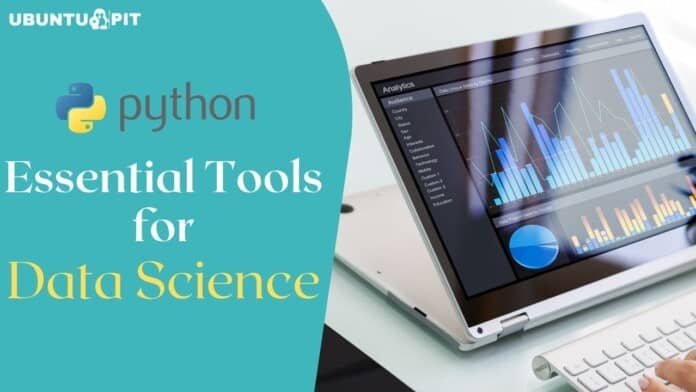Python is at its peak popularity due to its easy-to-understand syntax and versatile libraries. With that in mind, using Python tools for data science isn’t surprising. Data scientists do not have an easy job. They have to understand tons of complex ideas and polish existing data in order to interpret them.
To make things easier, Python tools containing various libraries exist to deal with such tedious tasks. For instance, data scientists have to analyze a large number of data and follow through with several processes to come to their conclusion. That means a lot of repetition is undoubtedly at play here – and Python tools are handy right now.
Must-Have Python Tools For Data Science
There are too many libraries in Python to count, so one cannot expect a single Python tool to have every library squished into it. Perhaps something like that will exist in the future, but for now, let’s look at the 10 best and essential Python tools for data science.
01. NumPy
 Numerical Python, also known as Numpy, is one of the core open-source Python libraries that is used for the bulk numerical calculation of data. The Numpy package comes with an object to work with arrays up to size N in a single go, meaning that the amount of data that one can calculate with Numpy is infinite and accessible. Moreover, the tool also covers a variety of arithmetic functions that make it all the more appealing for data scientists.
Numerical Python, also known as Numpy, is one of the core open-source Python libraries that is used for the bulk numerical calculation of data. The Numpy package comes with an object to work with arrays up to size N in a single go, meaning that the amount of data that one can calculate with Numpy is infinite and accessible. Moreover, the tool also covers a variety of arithmetic functions that make it all the more appealing for data scientists.
Key Specs
- Fundamental statistical and random numerical processes are included for better and more convenient data analysis.
- Carrying out bulk mathematical operations is almost instantaneous in Numpy; the heavy load doesn’t slow it down.
- It supports discrete Fourier transformations, which can be used to interpolate and clean up data.
- Exclusive matrices make it easier to do introductory linear algebra, which is crucial to data science.
- Vectorized calculations within the N-th dimension arrays make looping (in C) easier.
02. Vaex
 DataFrames are tables of data where every column contains information about different fields, and every row involves various records. Vaex is undoubtedly the best DataFrame library in Python and is one of the essential Python tools for data science. It is also highly efficient for saving up resources and using them only when needed – so it’s the best in situations with limited memory.
DataFrames are tables of data where every column contains information about different fields, and every row involves various records. Vaex is undoubtedly the best DataFrame library in Python and is one of the essential Python tools for data science. It is also highly efficient for saving up resources and using them only when needed – so it’s the best in situations with limited memory.
Key Specs
- Vaex supports lazy or delayed data evaluation, meaning that it works only on the user’s command.
- It can go through a billion rows of data each second, making it the fastest Python DataFrame tool.
- Basic statistical operations such as mean, mode, summation, standard deviation, etc., are feasible.
- Can visualize large Datasets in 1D, 2D, and 3D, which helps interpret data in a much more reliable manner.
- Uses Numpy arrays to store data in columns that can be memory-mapped.
03. Scikit-Learn
 Scikit-Learn is one of the best Python tools that connect data science to machine learning. It is a module that leverages the power of Numpy, Scipy, Matplotlib, and Cython to perform data analysis and other statistical applications such as clustering, regression, model selection, and much more. Also, the tool has almost all the machine learning algorithms, making it more versatile than ever.
Scikit-Learn is one of the best Python tools that connect data science to machine learning. It is a module that leverages the power of Numpy, Scipy, Matplotlib, and Cython to perform data analysis and other statistical applications such as clustering, regression, model selection, and much more. Also, the tool has almost all the machine learning algorithms, making it more versatile than ever.
Key Specs
- It’s packed with methods that enable the user to check if the results from data analysis are accurate or not.
- Has algorithms to efficiently perform lengthy mathematical operations such as Gauss-Jordan, Bayesian, Probability trees, etc.
- Uses feature extraction methods to reduce unnecessary data from visual or written datasets to help speed up data analysis processes.
- Can create discrete class labels for separating data categories, which helps in pattern recognition.
- Transformation features make it easier to manipulate data and predict future trends.
04. TensorFlow
 Matrix is an umbrella term that refers to tensors consisting of 2D arrays or vectors. However, tensors are mathematical objects much like matrices but can store data up to N number of dimensions. So tensors can store enormous amounts of data and work around them perfectly. The open-source TensorFlow tool makes use of that ideally and is an excellent contribution to data science, much like Scikit-Learn.
Matrix is an umbrella term that refers to tensors consisting of 2D arrays or vectors. However, tensors are mathematical objects much like matrices but can store data up to N number of dimensions. So tensors can store enormous amounts of data and work around them perfectly. The open-source TensorFlow tool makes use of that ideally and is an excellent contribution to data science, much like Scikit-Learn.
Key Specs
- It supports visualizing graph models point-to-point and focuses on details which may help interpret data with high accuracy.
- Feature columns help vectorize and transform the data inputs to perform operations leading to desired outputs for bulk datasets.
- Can perform several statistical operations that can help with Bayesian probability models.
- Debugging real-time data from graphical models in a visualizer is easy and fast in TensorFlow.
- Layered components can help optimize numerical data analysis with initializers that help maintain gradient scale.
05. Dask
 Parallel computing libraries in Python, such as Dask, make it possible to break down large tasks into smaller ones that can be executed simultaneously with the help of multi-core CPUs. It has several APIs that can help users use data science models in a secure and scalable fashion. Furthermore, the Dask tool has two components – one for scheduled data optimization and one for array extensions with interfaces such as NumPy or Pandas.
Parallel computing libraries in Python, such as Dask, make it possible to break down large tasks into smaller ones that can be executed simultaneously with the help of multi-core CPUs. It has several APIs that can help users use data science models in a secure and scalable fashion. Furthermore, the Dask tool has two components – one for scheduled data optimization and one for array extensions with interfaces such as NumPy or Pandas.
Key Specs
- Leverages NumPy and Pandas DataFrames for parallel computing when carrying out hefty tasks.
- Includes a Dask-Bag object that filters and maps data for extensive data collection.
- It runs on fast numeric algorithms through serialization and minimum runtime as well as using only memory necessary resources.
- Dask can also work in a single process instead of clusters when necessary by scaling down.
- Errors can be debugged locally in real time since the IPython kernel allows the user to investigate via a pop-up terminal that does not pause other operations.
06. Matplotlib
 Matplotlib is one of the essential Python tools for data science due to its revolutionary power in visualizing data. It is the ultimate Python library that supports a wide range of drawing types with its pyplot module. It is easy to learn and can create graphical models such as bar charts and histograms with a few lines of code and supports hardcopy formats as well as 2D and 3D plotting.
Matplotlib is one of the essential Python tools for data science due to its revolutionary power in visualizing data. It is the ultimate Python library that supports a wide range of drawing types with its pyplot module. It is easy to learn and can create graphical models such as bar charts and histograms with a few lines of code and supports hardcopy formats as well as 2D and 3D plotting.
Key Specs
- Can generate complex subplots semantically, which helps smooth out data for better analysis.
- Data visualization is more convenient as one can customize their axes in any way they want.
- It Uses legends, ticks, and labels for better data representation and has string and lambda functions for tick formatters.
- Saving figures while working with the backend can ensure data loss prevention when integrated with Jupyter Notebook.
- It has an interface that MATLAB inspired for more straightforward data visualization and manipulation.
07. Keras
 Keras is a Python-based advanced API for a more straightforward implementation of neural networks. One can also perform tensor-related calculations with it after customizing it in their own way. This is possible due to its official collaboration with TensorFlow. Some may complain about slow speed when using Keras, but its ease of usage and smooth learning curve for beginner data scientists is what gives it a spot on our list today.
Keras is a Python-based advanced API for a more straightforward implementation of neural networks. One can also perform tensor-related calculations with it after customizing it in their own way. This is possible due to its official collaboration with TensorFlow. Some may complain about slow speed when using Keras, but its ease of usage and smooth learning curve for beginner data scientists is what gives it a spot on our list today.
Key Specs
- Keras supports a vast amount of neural network models that help understand data even better.
- The tool comes with various deployment choices that reduce prototyping time for data models.
- One can use Keras with other libraries and tools due to its modular nature and customization support.
- It can help with pattern recognition by making predictions after evaluating a newly built model.
- As Keras has a simple network, it doesn’t often need debugging, so results are more reliable.
08. BeautifulSoup
 While BeautifulSoup is a Python library mainly built for parsing Html and XML documents, it is highly in demand when it comes to data scraping and web crawling, which indicates that the tool is perfect for data mining which is crucial to data science. One can easily scrape data from Html codes, saving data scientists a lot of time and effort. The tool can also be used with Selenium for dynamic data scraping methods.
While BeautifulSoup is a Python library mainly built for parsing Html and XML documents, it is highly in demand when it comes to data scraping and web crawling, which indicates that the tool is perfect for data mining which is crucial to data science. One can easily scrape data from Html codes, saving data scientists a lot of time and effort. The tool can also be used with Selenium for dynamic data scraping methods.
Key Specs
- Parses web pages like a browser do, so the interface is very user-friendly.
- Fast data scraping into tree structures to make data easy to read and manipulate.
- It is also able to crawl websites, meaning it can index data as it scrapes.
- Supports Jupyter Notebook integration that allows users to store and preview data in bulk.
- The parsing feature also helps with data analyzing and identifying semantic patterns.
09. Numba
 Numba is one of the fastest and most popular Python tools for data science that works with compiling Python code and speeding up arithmetic functions in CPU and GPU environments. It uses the LLVM compiler framework for compiling modules to a readable assembly language. Scheduling works much like Cython but with better features. One can quickly prototype data science projects in pure Python and deploy them almost instantly.
Numba is one of the fastest and most popular Python tools for data science that works with compiling Python code and speeding up arithmetic functions in CPU and GPU environments. It uses the LLVM compiler framework for compiling modules to a readable assembly language. Scheduling works much like Cython but with better features. One can quickly prototype data science projects in pure Python and deploy them almost instantly.
Key Specs
- The Latest Numba versions are highly memory efficient and have a GPU code reduction algorithm that compiles using necessary resources only.
- Supports CUDA accelerated codes and AMD ROCm APIs for even faster compiling.
- Can perform parallel computation for optimizing Just-In-Time compiled functions.
- Numba can also be integrated with NumPy for numerical computations with the help of NumPy arrays.
- The Boundscheck feature helps keep numerical arrays working smoothly and debug errors faster.
10. SciPy
 The SciPy library we are talking about is different from the SciPy stack – hence the features that it comes with aren’t to be confused with the other one. Much like NumPy, SciPy (Scientific Python) can solve mathematical algorithms, making it an asset in data science. However, SciPy has its own unique aspect of being more task-focused and science-oriented, making it better for utility functions and signal processing.
The SciPy library we are talking about is different from the SciPy stack – hence the features that it comes with aren’t to be confused with the other one. Much like NumPy, SciPy (Scientific Python) can solve mathematical algorithms, making it an asset in data science. However, SciPy has its own unique aspect of being more task-focused and science-oriented, making it better for utility functions and signal processing.
Key Specs
- Scipy comes with advanced commands and classes that can manipulate and visualize data, sub-packages for cluster algorithms, and more.
- It can process images up to the N-th dimension, much like NumPy arrays, but more scientifically to smooth out data.
- Can perform Fourier transformations to interpolate data and weed out anomalies.
- The LAPACK package based on Fortran can compute fundamental linear problems with ease.
- Supports NumPy integration to enhance numerical calculations and do vectorized looping with accuracy.
Take Away
In our discussion regarding the best and most essential python tools for data science today, we covered only a fragment of the existing tools. These tools are necessary for anyone who wishes to dive into data science and yearns to learn more about how it works.
However, we must remember that data science is not a small sector. It keeps evolving and demands more and more technological advancements from the world. Perhaps you will be its next contributor – so try your hands at these tools and explore! Also, we hope that you found this to be an interesting read and would love any feedback you leave behind. Thanks!


